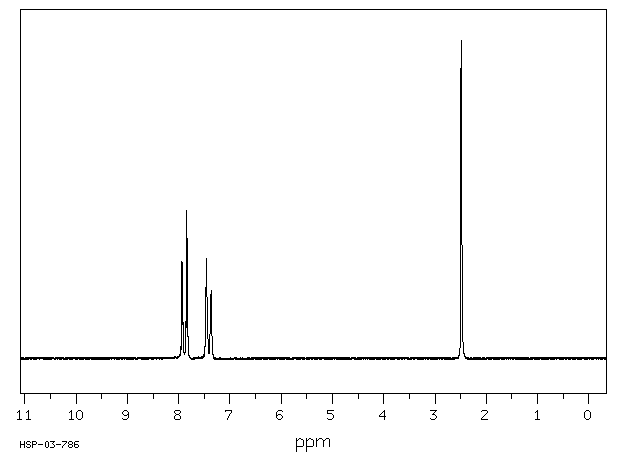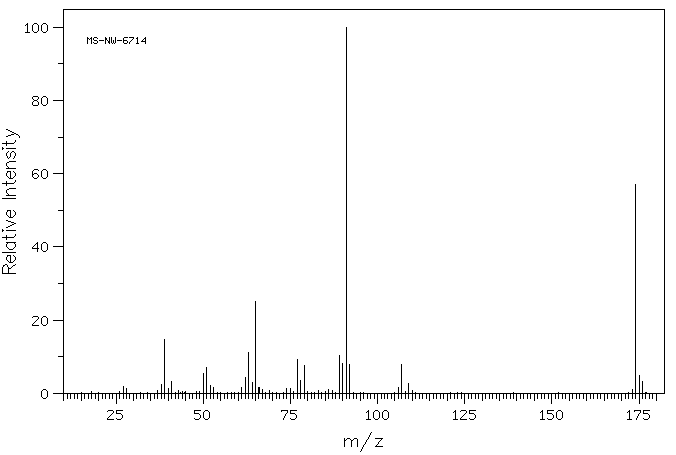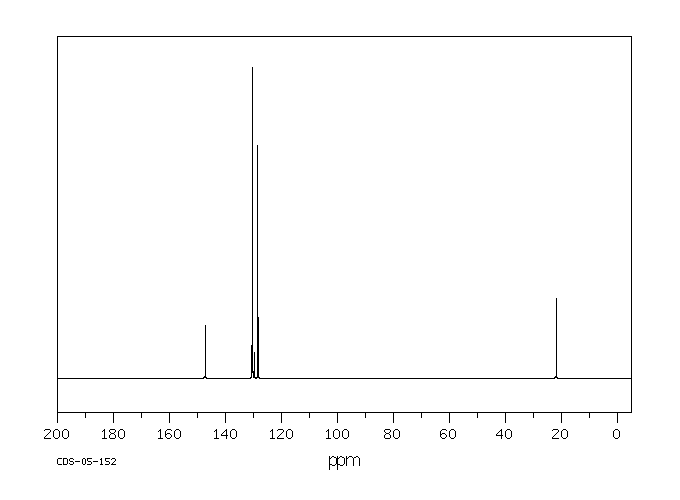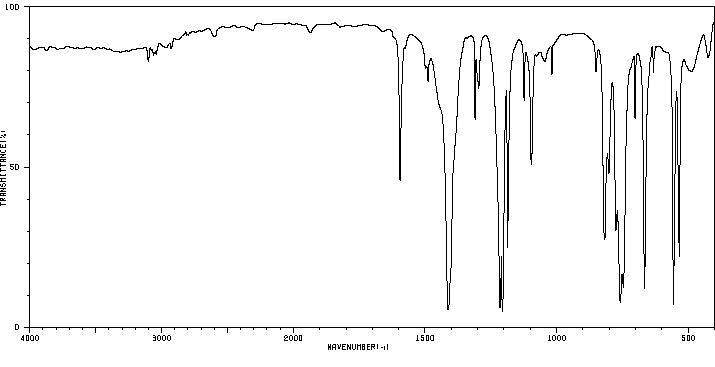对甲基苯磺酰氟 | 455-16-3
中文名称
对甲基苯磺酰氟
中文别名
对甲苯磺酰氟
英文名称
p-toluenesulfonyl fluoride
英文别名
para-toluenesulfonyl fluoride;4-methylbenzenesulfonyl fluoride;tosyl fluoride;4-toluenesulfonyl fluoride;TsF
CAS
455-16-3
化学式
C7H7FO2S
mdl
MFCD00007421
分子量
174.196
InChiKey
IZZYABADQVQHLC-UHFFFAOYSA-N
BEILSTEIN
——
EINECS
——
-
物化性质
-
计算性质
-
ADMET
-
安全信息
-
SDS
-
制备方法与用途
-
上下游信息
-
文献信息
-
表征谱图
-
同类化合物
-
相关功能分类
-
相关结构分类
物化性质
-
熔点:41-42 °C(lit.)
-
沸点:112 °C16 mm Hg(lit.)
-
密度:1.2768 (estimate)
-
闪点:222 °F
-
暴露限值:ACGIH: TWA 2.5 mg/m3NIOSH: IDLH 250 mg/m3
-
稳定性/保质期:
计算性质
-
辛醇/水分配系数(LogP):2.7
-
重原子数:11
-
可旋转键数:1
-
环数:1.0
-
sp3杂化的碳原子比例:0.142
-
拓扑面积:42.5
-
氢给体数:0
-
氢受体数:3
安全信息
-
TSCA:T
-
危险等级:8
-
危险品标志:C
-
安全说明:S22,S26,S27,S36/37/39,S45
-
危险类别码:R20/21/22,R34
-
WGK Germany:3
-
海关编码:2904909090
-
危险品运输编号:UN 3261 8/PG 2
-
RTECS号:XT8050000
-
包装等级:II
-
危险类别:8
-
危险标志:GHS05,GHS07
-
危险性描述:H302 + H312 + H332,H314
-
危险性防范说明:P280,P305 + P351 + P338,P310
-
储存条件:密封保存,并放置在通风且干燥的地方,避免与其它氧化物接触。
SDS
| Name: | P-Toluenesulfonyl Fluoride 97% Material Safety Data Sheet |
| Synonym: | 4-Methylbenzenesulfonyl Fluoride |
| CAS: | 455-16-3 |
Synonym:4-Methylbenzenesulfonyl Fluoride
Section 2 - COMPOSITION, INFORMATION ON INGREDIENTS
| CAS# | Chemical Name | content | EINECS# |
| 455-16-3 | P-Toluenesulfonyl Fluoride | 97% | 207-238-6 |
Risk Phrases: 34
Section 3 - HAZARDS IDENTIFICATION
EMERGENCY OVERVIEW
Causes burns.Moisture sensitive.Corrosive.
Potential Health Effects
Eye:
Causes eye burns. May cause chemical conjunctivitis and corneal damage.
Skin:
Causes skin burns. May cause skin rash (in milder cases), and cold and clammy skin with cyanosis or pale color.
Ingestion:
May cause severe and permanent damage to the digestive tract. Causes gastrointestinal tract burns. May cause perforation of the digestive tract. May cause cardiac disturbances. May cause central nervous system effects. May cause systemic effects.
Inhalation:
May cause severe irritation of the respiratory tract with sore throat, coughing, shortness of breath and delayed lung edema. Causes chemical burns to the respiratory tract. Aspiration may lead to pulmonary edema. May cause cardiac abnormalities. May cause systemic effects. Central nervous system effects, which appear to predominate in acute cases are characterized by abnormal fatigue, memory difficulties and dizziness.
Chronic:
Effects may be delayed.
Section 4 - FIRST AID MEASURES
Eyes: Get medical aid immediately. Do NOT allow victim to rub eyes or keep eyes closed. Extensive irrigation with water is required (at least 30 minutes).
Skin:
Get medical aid immediately. Immediately flush skin with plenty of water for at least 15 minutes while removing contaminated clothing and shoes. Wash clothing before reuse. Destroy contaminated shoes.
Ingestion:
Never give anything by mouth to an unconscious person. Get medical aid immediately. Do NOT induce vomiting. If conscious and alert, rinse mouth and drink 2-4 cupfuls of milk or water.
Inhalation:
Get medical aid immediately. Remove from exposure and move to fresh air immediately. If breathing is difficult, give oxygen. Do NOT use mouth-to-mouth resuscitation. If breathing has ceased apply artificial respiration using oxygen and a suitable mechanical device such as a bag and a mask.
Notes to Physician:
Section 5 - FIRE FIGHTING MEASURES
General Information:
As in any fire, wear a self-contained breathing apparatus in pressure-demand, MSHA/NIOSH (approved or equivalent), and full protective gear. During a fire, irritating and highly toxic gases may be generated by thermal decomposition or combustion. Contact with metals may evolve flammable hydrogen gas. Containers may explode when heated. Runoff from fire control or dilution water may cause pollution.
Extinguishing Media:
Do NOT use water directly on fire. Use water spray to cool fire-exposed containers. Use foam, dry chemical, or carbon dioxide.
Do NOT get water inside containers.
Section 6 - ACCIDENTAL RELEASE MEASURES
General Information: Use proper personal protective equipment as indicated in Section 8.
Spills/Leaks:
Vacuum or sweep up material and place into a suitable disposal container. Clean up spills immediately, observing precautions in the Protective Equipment section. Avoid generating dusty conditions.
Provide ventilation. Do not get water inside containers.
Section 7 - HANDLING and STORAGE
Handling:
Use only in a well-ventilated area. Minimize dust generation and accumulation. Do not breathe dust, vapor, mist, or gas. Do not get in eyes, on skin, or on clothing. Keep container tightly closed. Do not ingest or inhale. Do not allow contact with water. Discard contaminated shoes. Keep from contact with moist air and steam.
Storage:
Keep container closed when not in use. Corrosives area. Store protected from moisture.
Section 8 - EXPOSURE CONTROLS, PERSONAL PROTECTION
Engineering Controls:
Facilities storing or utilizing this material should be equipped with an eyewash facility and a safety shower. Use adequate ventilation to keep airborne concentrations low.
Exposure Limits CAS# 455-16-3: United States OSHA: 2.5 mg/m3 TWA (as F) (listed under Fluorides Personal Protective Equipment Eyes: Wear appropriate protective eyeglasses or chemical safety goggles as described by OSHA's eye and face protection regulations in 29 CFR 1910.133 or European Standard EN166.
Skin:
Wear appropriate protective gloves to prevent skin exposure.
Clothing:
Wear appropriate protective clothing to prevent skin exposure.
Respirators:
Follow the OSHA respirator regulations found in 29 CFR 1910.134 or European Standard EN 149. Use a NIOSH/MSHA or European Standard EN 149 approved respirator if exposure limits are exceeded or if irritation or other symptoms are experienced.
Section 9 - PHYSICAL AND CHEMICAL PROPERTIES
Physical State: Crystalline powder
Color: white to light beige
Odor: None reported.
pH: Not available.
Vapor Pressure: Not available.
Viscosity: Not available.
Boiling Point: 112 deg C @ 16.00mmHg
Freezing/Melting Point: 41.00 - 42.00 deg C
Autoignition Temperature: Not applicable.
Flash Point: 105 deg C ( 221.00 deg F)
Explosion Limits, lower: Not available.
Explosion Limits, upper: Not available.
Decomposition Temperature:
Solubility in water: hydrolysis
Specific Gravity/Density:
Molecular Formula: C7H7FO2S
Molecular Weight: 174.19
Section 10 - STABILITY AND REACTIVITY
Chemical Stability:
Stable under normal temperatures and pressures. May decompose on exposure to moist air or water.
Conditions to Avoid:
Incompatible materials, dust generation, moisture, excess heat, strong oxidants.
Incompatibilities with Other Materials:
Moisture, oxidizing agents, strong bases.
Hazardous Decomposition Products:
Carbon monoxide, oxides of sulfur, irritating and toxic fumes and gases, carbon dioxide, hydrogen fluoride gas.
Hazardous Polymerization: Has not been reported.
Section 11 - TOXICOLOGICAL INFORMATION
RTECS#:
CAS# 455-16-3: XT8050000 LD50/LC50:
Not available.
Carcinogenicity:
P-Toluenesulfonyl Fluoride - Not listed by ACGIH, IARC, or NTP.
Other:
See actual entry in RTECS for complete information.
Section 12 - ECOLOGICAL INFORMATION
Section 13 - DISPOSAL CONSIDERATIONS
Dispose of in a manner consistent with federal, state, and local regulations.
Section 14 - TRANSPORT INFORMATION
IATA
Shipping Name: CORROSIVE SOLID, N.O.S.*
Hazard Class: 8
UN Number: 1759
Packing Group: II
IMO
Shipping Name: CORROSIVE SOLID, N.O.S.
Hazard Class: 8
UN Number: 1759
Packing Group: II
RID/ADR
Shipping Name: CORROSIVE SOLID, N.O.S.
Hazard Class: 8
UN Number: 1759
Packing group: II
Section 15 - REGULATORY INFORMATION
European/International Regulations
European Labeling in Accordance with EC Directives
Hazard Symbols: C
Risk Phrases:
R 34 Causes burns.
Safety Phrases:
S 24/25 Avoid contact with skin and eyes.
WGK (Water Danger/Protection)
CAS# 455-16-3: No information available.
Canada
CAS# 455-16-3 is listed on Canada's NDSL List.
CAS# 455-16-3 is not listed on Canada's Ingredient Disclosure List.
US FEDERAL
TSCA
CAS# 455-16-3 is listed on the TSCA inventory.
SECTION 16 - ADDITIONAL INFORMATION
N/A
制备方法与用途
合成制备方法
用途
请提供具体的合成制备方法和用途内容,以便进行进一步的润色。
上下游信息
-
上游原料
中文名称 英文名称 CAS号 化学式 分子量 4-甲基苯磺酰溴 toluene-p-sulfonyl bromide 1950-69-2 C7H7BrO2S 235.101 对甲苯磺酰胺 toluene-4-sulfonamide 70-55-3 C7H9NO2S 171.22 对甲苯磺酸 toluene-4-sulfonic acid 104-15-4 C7H8O3S 172.205 -
下游产品
中文名称 英文名称 CAS号 化学式 分子量 对溴甲基苯磺酰氟 4-(bromomethyl)benzenesulfonyl fluoride 7612-88-6 C7H6BrFO2S 253.092 对甲砜基甲苯 Methyl p-tolyl sulfone 3185-99-7 C8H10O2S 170.232 对甲苯磺酸 toluene-4-sulfonic acid 104-15-4 C7H8O3S 172.205
反应信息
-
作为反应物:描述:参考文献:名称:吡啶鎓盐的直接 C-H 磺酰亚胺化摘要:已经开发了直接吡啶鎓 C-H 磺酰亚胺化,用于高效合成磺酰基亚氨基吡啶衍生物。这种转变的特点是在无金属条件下直接有效地形成具有高官能团耐受性的 C=N 键。光谱特性可能使这些磺酰基亚氨基吡啶化合物成为有用的新型发光材料。DOI:10.1021/acs.orglett.2c00725
-
作为产物:参考文献:名称:使用NBS / NCS – i PrOH通过硫醇氧基卤化合成磺酰卤摘要:一种快速而简便的方法,是使用NXS – ROH(X = Br,Cl,R = i Pr)作为氧卤代试剂氧化硫醇,从而提供了磺酰溴/氯化物的一般途径 。对照实验表明,酒精成分是氧气的来源。所提出的方法使得能够获得结构上不同的磺酰溴和氯化物,包括具有挑战性的实例,这是其他合成方法所无法达到的。DOI:10.1016/j.tetlet.2017.04.087
-
作为试剂:描述:2,2-二甲基-1,3-环己烷二酮 在 lithium aluminium tetrahydride 、 对甲基苯磺酰氟 、 三氟化硼乙醚 、 1,8-二氮杂双环[5.4.0]十一碳-7-烯 、 lithium hexamethyldisilazane 作用下, 以 四氢呋喃 、 甲苯 为溶剂, 反应 86.83h, 生成 (2'R,4'aS,8'aR)-4'a,8',8'-trimethyl-2'-propan-2-ylspiro[1,3-dioxolane-2,7'-2,3,4,5,6,8a-hexahydrochromene]参考文献:名称:[EN] NRF2 ACTIVATOR
[FR] ACTIVATEUR DE NRF2摘要:公开号:WO2018140738A8
文献信息
-
<i>N</i>-Ammonium Ylide Mediators for Electrochemical C–H Oxidation作者:Masato Saito、Yu Kawamata、Michael Meanwell、Rafael Navratil、Debora Chiodi、Ethan Carlson、Pengfei Hu、Longrui Chen、Sagar Udyavara、Cian Kingston、Mayank Tanwar、Sameer Tyagi、Bruce P. McKillican、Moses G. Gichinga、Michael A. Schmidt、Martin D. Eastgate、Massimiliano Lamberto、Chi He、Tianhua Tang、Christian A. Malapit、Matthew S. Sigman、Shelley D. Minteer、Matthew Neurock、Phil S. BaranDOI:10.1021/jacs.1c03780日期:2021.5.26taking a first-principles approach guided by computation, these new mediators were identified and rapidly expanded into a library using ubiquitous building blocks and trivial synthesis techniques. The ylide-based approach to C–H oxidation exhibits tunable selectivity that is often exclusive to this class of oxidants and can be applied to real-world problems in the agricultural and pharmaceutical sectors强 C(sp 3 )-H 键的位点特异性氧化在有机合成中具有无可争议的效用。从简化对代谢物的获取和先导化合物的后期多样化到截断逆合成计划,学术界和工业界都越来越需要新的试剂和方法来实现这种转变。当前化学试剂的一个主要缺点是在结构和反应性方面缺乏多样性,这阻碍了用于快速筛选的组合方法的使用。在这方面,定向进化仍然最有希望在各种复杂环境中实现复杂的 C-H 氧化。在此,我们提出了一个设计合理的平台,该平台使用N-铵叶立德作为电化学驱动的氧化剂,用于位点特异性、化学选择性 C(sp 3 )-H 氧化。通过采用以计算为指导的第一性原理方法,这些新的介质被识别出来,并使用无处不在的构建块和简单的合成技术迅速扩展到一个库中。基于叶立德的 C-H 氧化方法表现出可调的选择性,这通常是此类氧化剂独有的,可应用于农业和制药领域的实际问题。
-
Arenesulfonyl Fluoride Synthesis via Copper-Catalyzed Fluorosulfonylation of Arenediazonium Salts作者:Yongan Liu、Donghai Yu、Yong Guo、Ji-Chang Xiao、Qing-Yun Chen、Chao LiuDOI:10.1021/acs.orglett.0c00484日期:2020.3.20We report herein a general and practical copper-catalyzed fluorosulfonylation reaction of a wide range of abundant arenediazonium salts to smoothly prepare various arenesulfonyl fluorides using the 1,4-diazabicyclo[2.2.2]octane-bis(sulfur dioxide) adduct as a convenient sulfonyl source in combination with KHF2 as an ideal fluorine source and without the need for additional oxidants. Interestingly,
-
Fluorosulfonylation of arenediazonium tetrafluoroborates with Na2S2O5 and N-fluorobenzenesulfonimide作者:Shuai Liu、Yangen Huang、Xiu-Hua Xu、Feng-Ling QingDOI:10.1016/j.jfluchem.2020.109653日期:2020.12the three-component reaction of arenediazonium tetrafluoroborates, Na2S2O5, and N-fluorobenzenesulfonimide (NFSI). The reaction proceeds through a radical tandem process, affording various arenesulfonyl fluorides in moderate to high yields. This protocol not only provides a complement to the previous fluorosulfonylation reactions, but also extends the applications of Sandmeyer reaction.
-
[EN] METHODS FOR PRODUCING ARYLSULFUR PENTAFLUORIDES<br/>[FR] PROCÉDÉS DE PRODUCTION DE PENTAFLUORURES DE SOUFRE ARYLÉS申请人:IM & T RES INC公开号:WO2010014665A1公开(公告)日:2010-02-04Novel methods for preparing arylsulfur pentafluorides are disclosed. Arylsulfur halotetrafluoride is reacted with a fluoride source under hydrous conditions to form an arylsulfur pentafluoride. The purification method is also disclosed.
-
Selective electrolytic fluorinations in 70% HF/30% pyridine作者:Sarah M. Lee、Jamie M. Roseman、C. Blair Zartman、Eamonn P. Morrison、Sean J. Harrison、Corrie A. Stankiewicz、W.J. MiddletonDOI:10.1016/0022-1139(95)03379-3日期:1996.3The selective fluorination of compounds containing benzylic hydrogen atoms was accomplished by electrolysis in a mixture of 70% HF and 30% pyridine (Olah's reagent) using a square wave alternating current (1.76–2.75 V, 0.02–0.05 Hz) and Pt electrodes. This method can be used in the laboratory to prepare conveniently gram-size quantities of monofluorinated products. An ion radical mechanism has been
表征谱图
-
氢谱1HNMR
-
质谱MS
-
碳谱13CNMR
-
红外IR
-
拉曼Raman
-
峰位数据
-
峰位匹配
-
表征信息
同类化合物
(βS)-β-氨基-4-(4-羟基苯氧基)-3,5-二碘苯甲丙醇
(S,S)-邻甲苯基-DIPAMP
(S)-(-)-7'-〔4(S)-(苄基)恶唑-2-基]-7-二(3,5-二-叔丁基苯基)膦基-2,2',3,3'-四氢-1,1-螺二氢茚
(S)-盐酸沙丁胺醇
(S)-3-(叔丁基)-4-(2,6-二甲氧基苯基)-2,3-二氢苯并[d][1,3]氧磷杂环戊二烯
(S)-2,2'-双[双(3,5-三氟甲基苯基)膦基]-4,4',6,6'-四甲氧基联苯
(S)-1-[3,5-双(三氟甲基)苯基]-3-[1-(二甲基氨基)-3-甲基丁烷-2-基]硫脲
(R)富马酸托特罗定
(R)-(-)-盐酸尼古地平
(R)-(-)-4,12-双(二苯基膦基)[2.2]对环芳烷(1,5环辛二烯)铑(I)四氟硼酸盐
(R)-(+)-7-双(3,5-二叔丁基苯基)膦基7''-[((6-甲基吡啶-2-基甲基)氨基]-2,2'',3,3''-四氢-1,1''-螺双茚满
(R)-(+)-7-双(3,5-二叔丁基苯基)膦基7''-[(4-叔丁基吡啶-2-基甲基)氨基]-2,2'',3,3''-四氢-1,1''-螺双茚满
(R)-(+)-7-双(3,5-二叔丁基苯基)膦基7''-[(3-甲基吡啶-2-基甲基)氨基]-2,2'',3,3''-四氢-1,1''-螺双茚满
(R)-(+)-4,7-双(3,5-二-叔丁基苯基)膦基-7“-[(吡啶-2-基甲基)氨基]-2,2”,3,3'-四氢1,1'-螺二茚满
(R)-3-(叔丁基)-4-(2,6-二苯氧基苯基)-2,3-二氢苯并[d][1,3]氧杂磷杂环戊烯
(R)-2-[((二苯基膦基)甲基]吡咯烷
(R)-1-[3,5-双(三氟甲基)苯基]-3-[1-(二甲基氨基)-3-甲基丁烷-2-基]硫脲
(N-(4-甲氧基苯基)-N-甲基-3-(1-哌啶基)丙-2-烯酰胺)
(5-溴-2-羟基苯基)-4-氯苯甲酮
(5-溴-2-氯苯基)(4-羟基苯基)甲酮
(5-氧代-3-苯基-2,5-二氢-1,2,3,4-oxatriazol-3-鎓)
(4S,5R)-4-甲基-5-苯基-1,2,3-氧代噻唑烷-2,2-二氧化物-3-羧酸叔丁酯
(4S,4''S)-2,2''-亚环戊基双[4,5-二氢-4-(苯甲基)恶唑]
(4-溴苯基)-[2-氟-4-[6-[甲基(丙-2-烯基)氨基]己氧基]苯基]甲酮
(4-丁氧基苯甲基)三苯基溴化磷
(3aR,8aR)-(-)-4,4,8,8-四(3,5-二甲基苯基)四氢-2,2-二甲基-6-苯基-1,3-二氧戊环[4,5-e]二恶唑磷
(3aR,6aS)-5-氧代六氢环戊基[c]吡咯-2(1H)-羧酸酯
(2Z)-3-[[(4-氯苯基)氨基]-2-氰基丙烯酸乙酯
(2S,3S,5S)-5-(叔丁氧基甲酰氨基)-2-(N-5-噻唑基-甲氧羰基)氨基-1,6-二苯基-3-羟基己烷
(2S,2''S,3S,3''S)-3,3''-二叔丁基-4,4''-双(2,6-二甲氧基苯基)-2,2'',3,3''-四氢-2,2''-联苯并[d][1,3]氧杂磷杂戊环
(2S)-(-)-2-{[[[[3,5-双(氟代甲基)苯基]氨基]硫代甲基]氨基}-N-(二苯基甲基)-N,3,3-三甲基丁酰胺
(2S)-2-[[[[[((1S,2S)-2-氨基环己基]氨基]硫代甲基]氨基]-N-(二苯甲基)-N,3,3-三甲基丁酰胺
(2S)-2-[[[[[[((1R,2R)-2-氨基环己基]氨基]硫代甲基]氨基]-N-(二苯甲基)-N,3,3-三甲基丁酰胺
(2-硝基苯基)磷酸三酰胺
(2,6-二氯苯基)乙酰氯
(2,3-二甲氧基-5-甲基苯基)硼酸
(1S,2S,3S,5S)-5-叠氮基-3-(苯基甲氧基)-2-[(苯基甲氧基)甲基]环戊醇
(1S,2S,3R,5R)-2-(苄氧基)甲基-6-氧杂双环[3.1.0]己-3-醇
(1-(4-氟苯基)环丙基)甲胺盐酸盐
(1-(3-溴苯基)环丁基)甲胺盐酸盐
(1-(2-氯苯基)环丁基)甲胺盐酸盐
(1-(2-氟苯基)环丙基)甲胺盐酸盐
(1-(2,6-二氟苯基)环丙基)甲胺盐酸盐
(-)-去甲基西布曲明
龙蒿油
龙胆酸钠
龙胆酸叔丁酯
龙胆酸
龙胆紫-d6
龙胆紫










